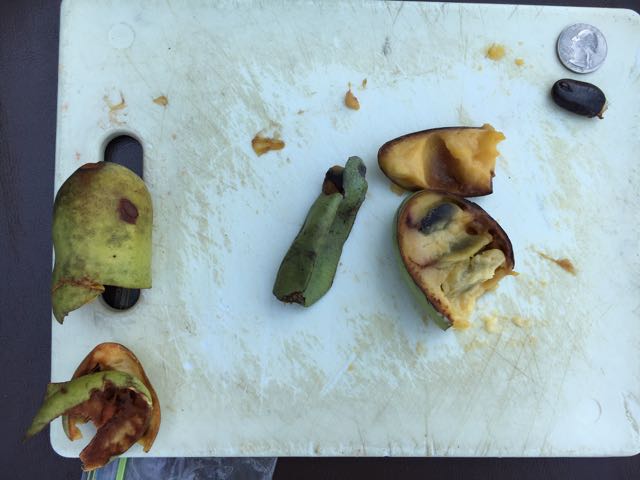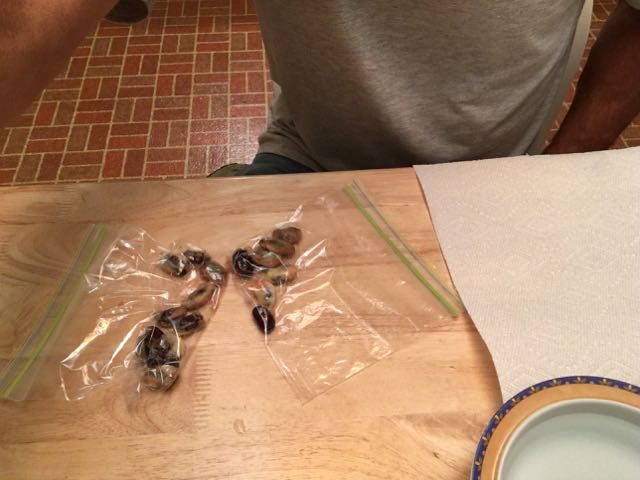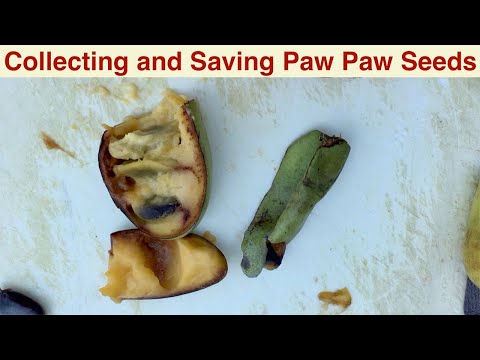This post is about How to Collect Save and Store Paw Paw Seeds. We talk about the basics as far as what paw paw trees are and their needs, as well as how to collect, store, and plant the seeds.

The Basics
The paw paw tree (Asimina triloba) is a deciduous tree (and can be a shrub) native to eastern North America. It can grow to a height of 35 feet with a slight tropical look to it. It has edible fruit and is a good understory tree.
Fruit and Seeds
The conspicuous fruits begin developing after the plants flower; they are initially green, maturing in mid-September to October to a yellow or brown color. The pawpaw is the largest edible fruit native to North America. Individual fruits weigh 5 to 16 ounces and are 3 to 6 inches in length. The fruit usually has 10 to 14 seeds in two rows. The brownish to blackish seeds are shaped like lima beans, with a length of 1/2 to 1-1/2 inches. Pawpaw fruits often occur as clusters of up to nine individual fruits.

Edible
The yellow flesh is custard like and highly nutritious with a tropical flavor that resembles a combination of banana, mango, and pineapple. Fresh fruits of the pawpaw are commonly eaten raw, either chilled or at room temperature. However, they can be kept only 2–3 days at room temperature, or about a week if refrigerated
The easily bruised pawpaw fruits do not ship well unless frozen. The fruit can be blended into ice cream or included in pancakes. Paw paws are also used for juice-making, and made into a country wine.
Propagation
Trees are easily grown from seed. Pawpaw seeds must receive a 90 to 120-day stratification. Sexual reproduction by seed does also occur in the wild, but at a fairly low rate. This rate can be increased by hand pollinating the flowers. Desirable kinds (cultivars) of pawpaw are propagated by whip grafting. Paw paws spread locally primarily by root suckers.

Clean the Seeds
The first step in propagating paw paw from seed is to collect the seeds and then clean the pulp off of the seeds. Once the pulp is off you may want to clean the seeds with a 10% bleach solution. I did this to one set of seeds and did not do it to another set. The 10% solution is made by measuring out 9 parts water and 1-part bleach. Just soak the seeds in the solution for about 5 to 10 minutes and then rinse them off. This prevents the seeds from getting moldy while they are stratifying (see below).

Never Dry the Seeds
One point to keep in mind is to never let the seeds dry out. If the seeds dry out the germination rate goes down to 20% or less.
Stratify
Now we want to cold stratify the seeds. Cold stratification is a natural occurrence that happens with the seeds that tells the seeds when to break dormancy. In the wild the fruit falls to the ground and gets covered with falling leaves and debris. The fruit eventually rots away or is eaten by wildlife, leaving the seeds.
Nature does not want the seeds to germinate in the fall or winter, so a safety mechanism is built into them that requires them to have 90 to 120 days of cold weather before they will germinate. After this time period, when the weather starts to get warmer, the seeds will germinate. This can only happen in the spring, so the plant has all spring, summer, and into the fall to get a good root system down.
You can find more information on how to stratify seeds here.
Your Choice
You have a choice. Plant the paw paw seeds outside in the fall so they can cold stratify or fake the seeds out and cold stratify the seeds yourself. Faking them out is done by putting the in the refrigerator for 90 to 120 days.
Two things to keep in mind. Do not freeze the seeds and do not let the seeds dry out. You can keep the seeds moist by wetting some potting soil or Pete moss, adding the seeds, and putting them into a plastic bag. I usually use a sandwich bag.
How Wet
As for how wet to make the soil, here is the rule of thumb: wet it enough so it is moist but not saturated. You want to be able to grab a handful of soil and squeeze it and get one drop of water out. No more and no less.
Label and Refrigerate
Make sure you label the plastic bag with the date that you are putting it into the refrigerator. I usually put the bag in one of the drawers in the bottom of the refrigerator so it is out of the way.
Plant
When the time is up, take the seeds out of the potting mix or Pete moss and plant them. As a general rule you plant seeds as deep as they are tall. If your seeds are 1-inch tall, then plant them 1-inch deep.
Limit the Sun
Paw paw trees do not like excessive sun when they are young. They prefer dappled sun to part shade for the first year or two. After that, give them full sun. I’m going to come up with a shade cloth or some mechanism to put around them for the first two years in the ground. After that I can simply remove whatever mechanism I come up with and they will be in full sun.
The Video
Please check out the video below titled Collecting and Saving Paw Paw Seeds.
Thanks for visiting the How to Collect Save and Store Paw Paw Seeds post.
Want to Help a Small Business?
If you are local you can support our small business by buying plants at Great Escape Nursery . You can also help us by shopping on Amazon just by going through our storefront! As an Amazon Associate, I earn commission from qualifying purchases. There is no additional cost to you! Our storefront at Amazon is located at this link: https://www.amazon.com/shop/greatescapefarms. Buying from either location helps our business produce more content for you.
If you like this blog post and want to find out more about Great Escape Farms check out our Great Escape Farms Overview. Here you get an overview of all the wonderful stuff we are involved in. Also, sign up for our email list at the bottom of the linked page.
Great Escape Farms is now on Patreon! You can support us for as little as $1. If you enjoy our work and want to help support us, please check out our Patreon page at: https://www.patreon.com/gef.

Leave a Reply